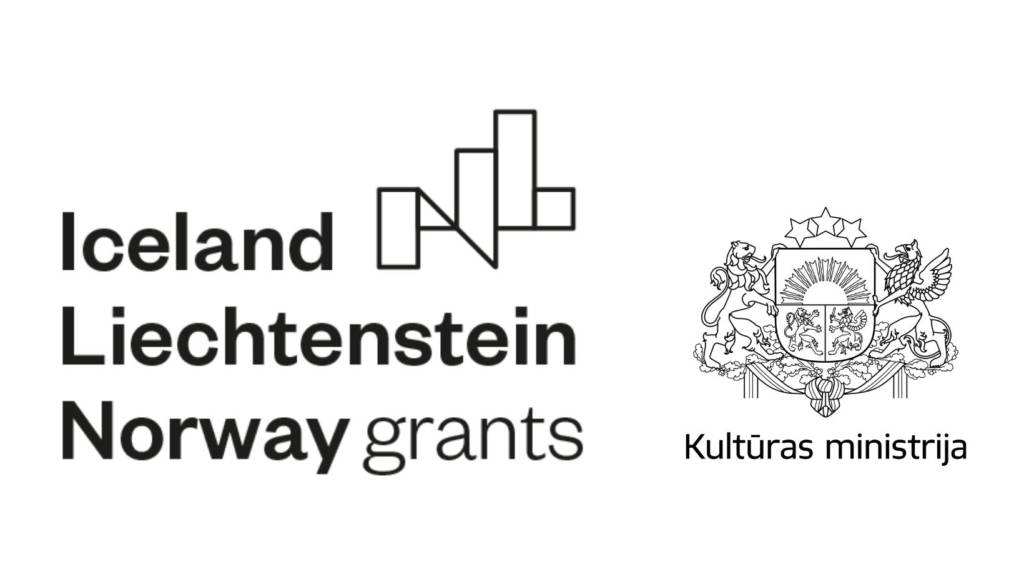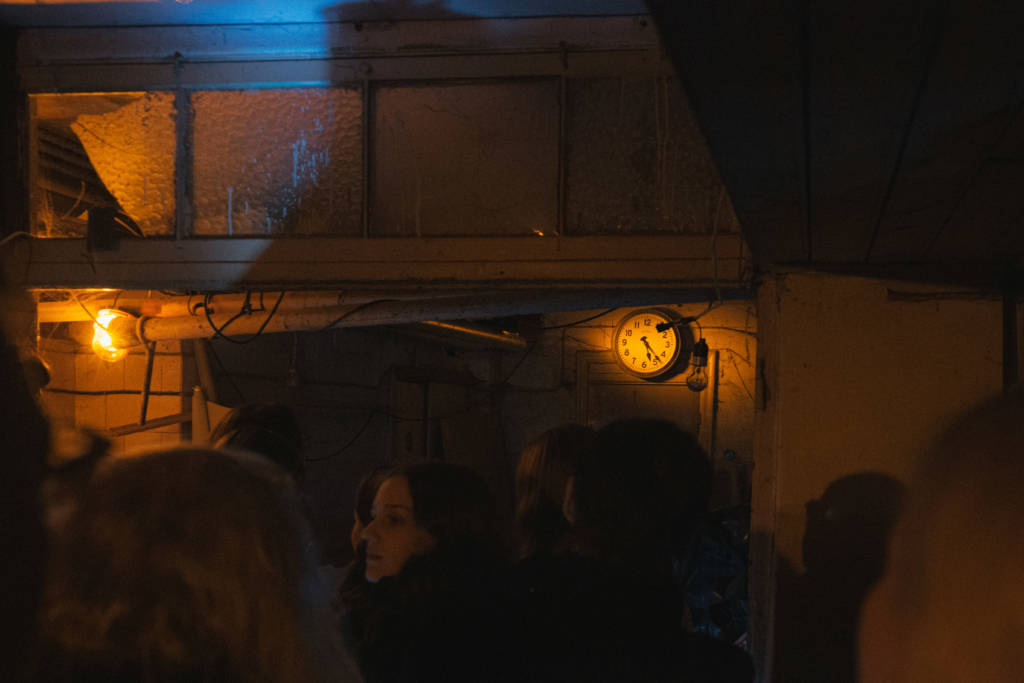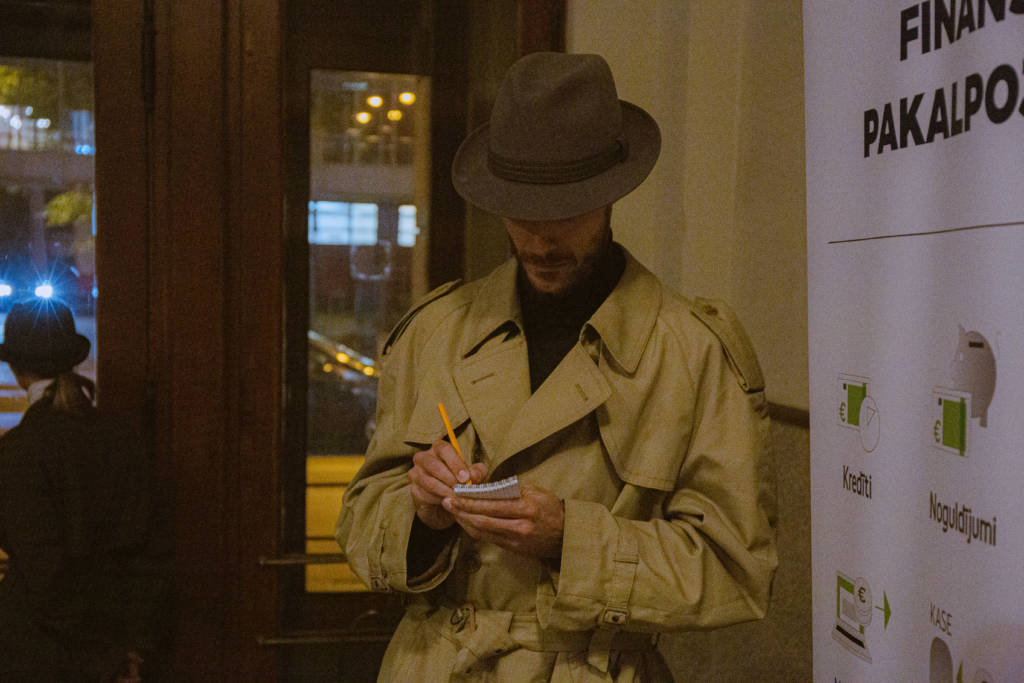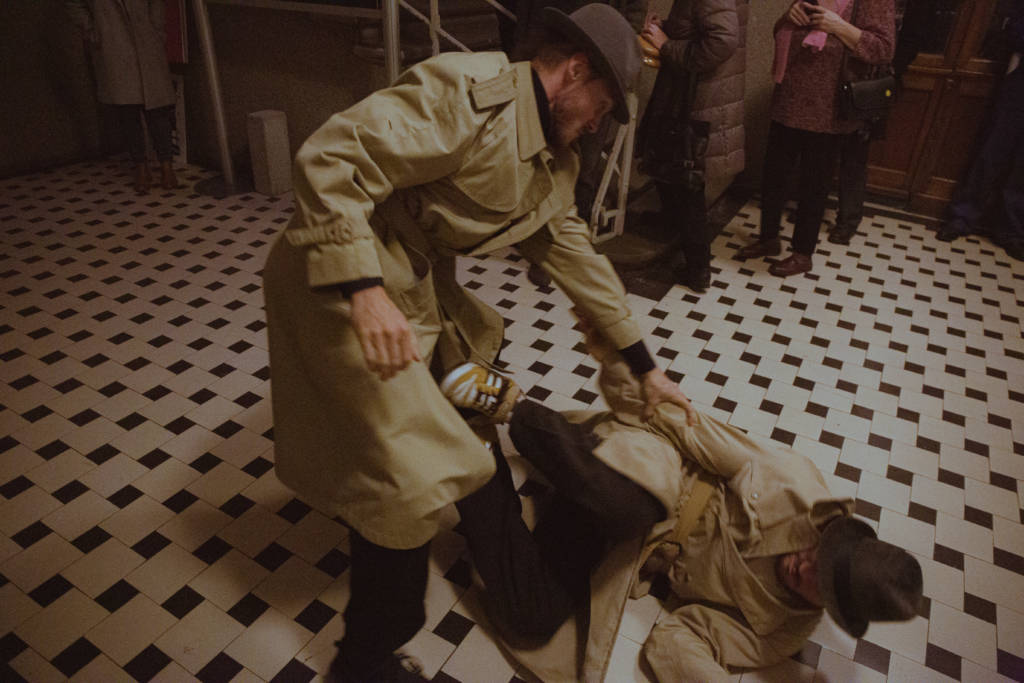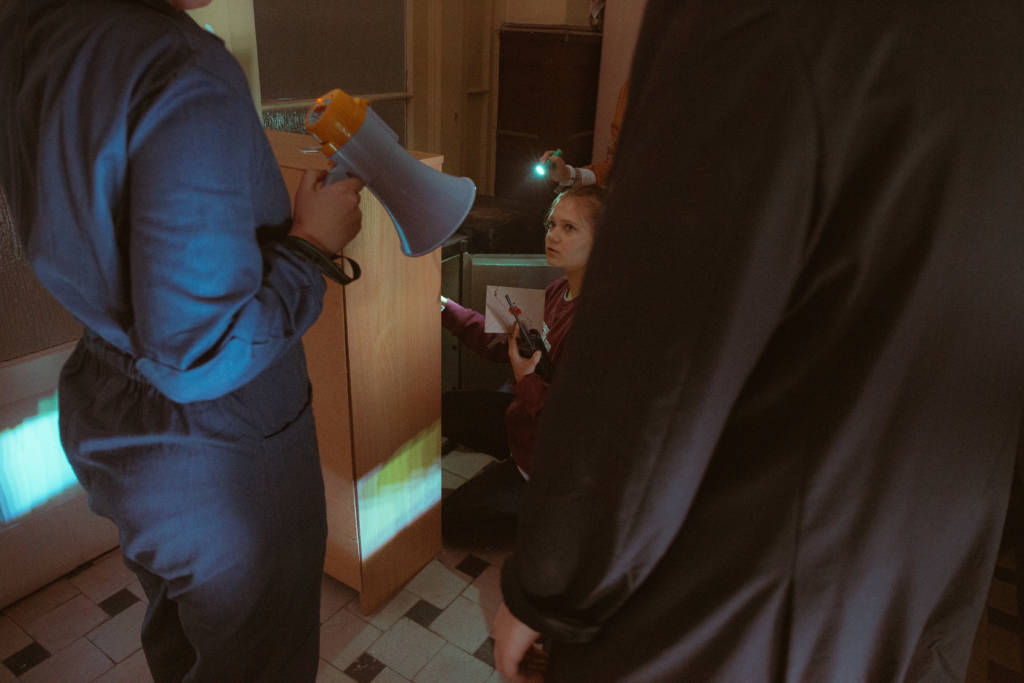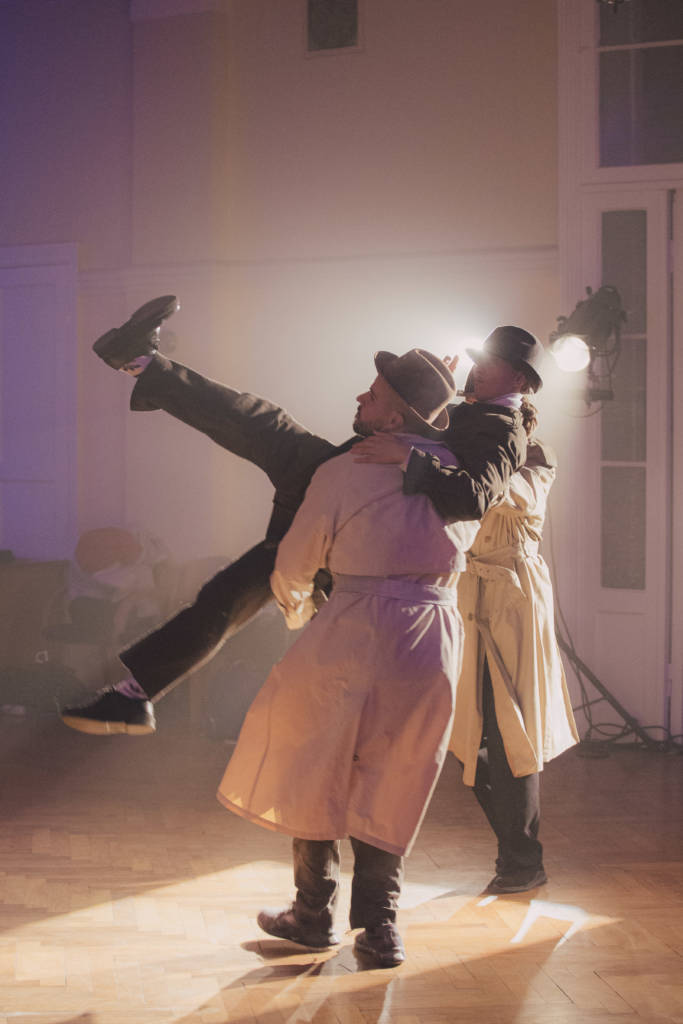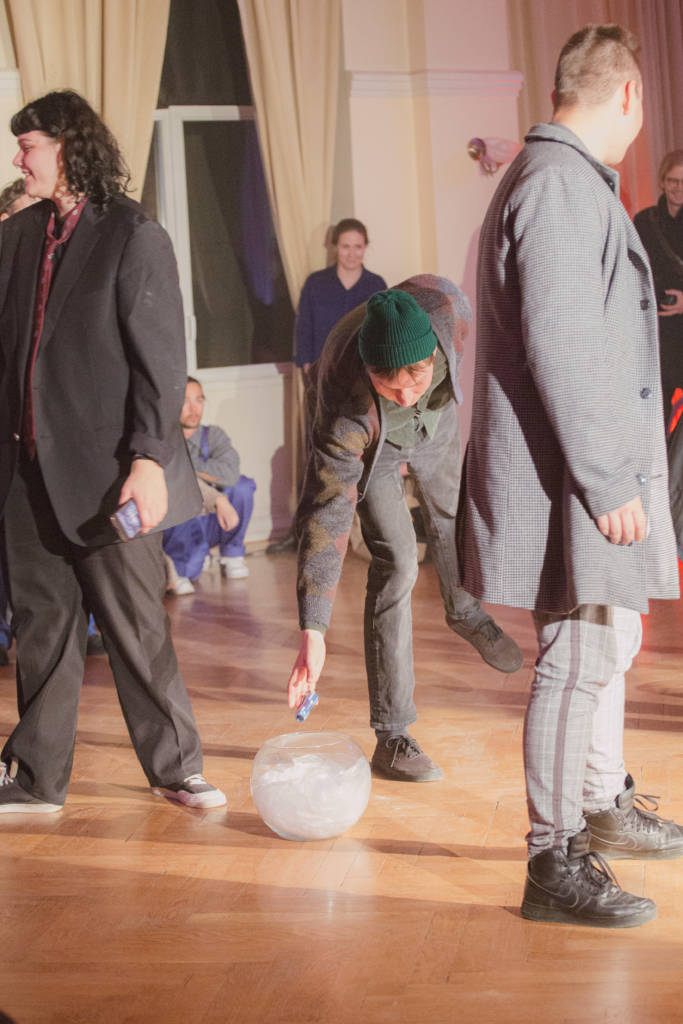Participatory art events for young people <<Līdzinieki>> earned the warm response of young people. Publicist Santa Remere wrote a review together with five young people. Three students of the Riga Art and Media Technical School filmed and created a video story. The show was created in consultation with a focus group of the target audience.
REVIEW
What is the air like at the epicenter of the coup? The performance <<Līdzinieki>> is evaluated by high school students
Interactive performance “Līdzinieki”
2022, November 5, 11:00
The review was made in cooperation with Latvian Radio and the news portal of Latvian Television and published in the lsm.lv section Skatuve
Author: Santa Remere (publicist)
On October 12 of this year, the premiere of an unprecedented theatrical event took place – a large-scale, interactive performance <<Līdzinieki>> for young people created by director Edgars Niklasons in cooperation with the cultural center “I-Dejas māja”, the foundation “Initium” and the Norwegian theater “K:13”, involving a wide cast of local actors, artists and dancers. What is impressive about this project is not only the composition of the show, but also the planned target audience – the creators have committed to involve a hundred high school-age spectators in each show – and the setting to replicate the night of the Ulmans coup on May 15, 1934, inviting young viewers to delve into questions about Latvian democracy at that time and today. Five high school students from the training program for young festival curators “Apvērsums” also experienced the performance and expressed their assessment.
Historian Edgars Dunsdorf has said that May 15 is a date that divided Latvian society like no other. It was a moment in the history of our democratic republic, when members of many social-democratic organizations were arrested because of their party affiliation, many civil servants, municipal employees, teachers lost their jobs, unions were closed and a large part of public organizations, press publications, as well as non-governmental educational institutions were liquidated. There is also an opinion that it was Ulmanis’s violent seizure of power and interference in the lives of citizens that largely caused the opposition to this regime and contributed to the widespread opposition, which later “welcomed the changes of 1940 with hope, which turned into the occupation of the country”. It was an excess that we probably could have gotten away with and certainly wouldn’t want to experience again.
Historian Edgars Dunsdorf has said that May 15 is a date that divided Latvian society like no other. It was a moment in the history of our democratic republic, when many social-democratic organizations were arrested because of their party affiliation. Against the background of the current geopolitical situation, when the fear of repeating the worst moments of history is in the air, and when civilians are arrested right here in neighboring countries for protests against authoritarian rule, it is especially important for these to talk about issues with the wider society – including the younger age groups, who, like everyone, have many questions and who are perhaps even more affected by a panicked desire to understand something and look for a model of action that would also take into account their interests and position. The show comes with a proposal to test the principles of democracy together – get into a “time machine” and walk through the cellars of history (also in the literal sense – the show took place in the historic House of the People or Trade Unions, which housed the Latvian Social Democratic Workers’ Party (LSDSP) and other social democratic organizations in the thirties), trying through interactive dramaturgy based on breakout game principles, to identify how the decisions of the crowd are formed, what are its driving forces and what are the possibilities of the individual to influence the joint decisions and historical events.
This is an ambitious and bold application that undeniably raises the interest and expectations of the audience as well. The fact that the show is intended for the youngest audience should not become a reason for simplifying the theme or deviating from it, but rather it imposes an even greater responsibility to present all elements as thoughtfully as possible. 100 spectators participate in the show at the same time, who are first lined up in the courtyard of the building by the organizers, putting ” to count to “one – two” like in high school. After that, we hand over our bags, get flashlights, and the actor Marħer Majors leads us through the premises of the House of Trade Unions. We are constantly encouraged to move faster, repeatedly climb up and down the stairs, where in a rather witty way we we are introduced to Latvian greats and we watch several performances of modern dance groups.Then we divide into 3 groups and go to the “breakout room” of Čaks, Rainis or Ziemelnieks, where a completely different rhythm already prevails and the participation of the audience is more expected.
At least the Ziemelnieks’s room has a pleasantly oriental, meditative vibe – implying that he’s into intoxicants – and we all relaxed so much that we didn’t even want to break out or do the quest, apart from the few of us who were arrested and taken to the attic. However, it was not clear until the end, did we save them and find the right password? And what did it matter that the walkie-talkies our group had to use to communicate with the group in the other room didn’t work very well? Why are the great spirits of the people personified on the night of the arrest of the social democrats by Rainis, Čak and Ziemenieks, two of whom are no longer among the living at that time? Which of the elements are random and which are purposeful? And who exactly are we, the audience of this show – like-minded people or just bystanders? In our passivity, are we really the counterparts of the citizens of the former free state of Latvia? Or was this all a story about the lack of communication – “silent phones” in the hands of inept radio operators and the fact that everyone can become the most important chain link in a crisis situation, so the ability to think along, be alert and take the initiative should be trained on a daily basis?
I have a feeling that the creators of the show have deliberately developed several symbolic elements and stopping points related to the building and the era, but left the search for connections between them and between the different eras completely up to the audience. This is probably indicated by the unusual syntax already used in the name and description of the show (“exhibition=show”), where the sign “>” placed on both sides of the name leads to think that the concept of equivalence will be tested here under high tension – pulled on both sides and the result we, the creators, know as little as the next Saeima elections. Connecting elements between ideas and concepts seem conceptually more important in the entire structure and course of the performance – stairs, corridors, tunnels, movement in their own way reflect processes, searches and the way we exist together.
Opinions
I have a feeling that the creators of the show have deliberately developed several symbolic elements and stopping points related to the building and the era, but left the search for connections between them and between the different eras completely up to the audience. On that, perhaps, the part of the “exhibition” would be said to have been quite successful – this is a unique opportunity to look into the historically important Trade Union House without a fixed focus. It is more difficult for me to comment on the “show” part, because I am not its direct target audience. That’s why I came to the show together with five high school students from the “Coup” training program for young festival curators, and in the name of democracy and equality, I left the evaluation of the show up to them.
Samuels Ozoliņš: Have you seen a breakout room or a quest with more than 100 people who have to break out? Usually it is offered to companies of up to 10 people, but Niklasons and his team created a quest for a whole crowd in the show “Līdzinieki”. Already after reading the description, I understand that from the point of view of organization it is complete madness, a producer’s nightmare, so a big praise to the producers of this event (Ieva Niedre, Charlotte Foberg-Johansen and the “Initium” foundation) who took it upon themselves to realize such an ambitious event and that the show really took place – not a single viewer got lost in the giant building, the actors, lighting and tuners did their job. However, from the viewer’s point of view, the feeling was nightmarish – it seems that for at least half of the performance (an hour and a half) we were given instructions, told what would happen, what and how to do, there was a noticeable confusion, crowd, noise, which, however, is not associated with the night of 1934 events. A performance of this type would function much better and be more enjoyable for both the audience and the actors with a smaller number of visitors. It seems that mixing elements from different times / eras together was a deliberate directing technique, but I don’t see any particular sense or justification for it. The elements of contemporary dance seemed very appropriate and refreshing, however, the amount of hip-hop dance seemed excessive and did not compliment the plot. However, I would like to mention the excellent work of the background actors – trade union members, visitors to the building, secret police, despite the huge amount of people and chaos, the ability to stay in their places and characters – as well as the visual design of the show – scenography, installation by artists Ance Eikena and Anita Rozentāle, and lights were important factors creating the overall atmosphere of the show.
Karu Treij: I definitely felt nervous coming to the show. Even the choice of the building indicated that something special would happen. The show started quite soon after the scheduled start time. There were many people who came, the large crowd moved inside, where we were divided into groups, which were already huge. Everything was going well though until the “breakout room” part started (I was in Chuck’s room) where there was just waiting and messing around while the cast-managers tried to cheer us up. The only ones who slightly dispelled the gloomy atmosphere were the Chekists. The dance performances also increased the value of the show, but could not hold all the often different parts of the show together. What really didn’t work this time, in my opinion, was precisely the elements of the breakout room – the tasks were more like a school excursion than a game or a play. It seemed that the idea of the game was only being reworked and lost the spirit of the show. All in all, though, it was kind of an adventure, and I don’t regret taking part.
Ikars Graždanovičs: I can describe the show in simple but contradictory words – it was bad, but I liked it. The theme, choreography and scenography of the show combine in an interesting and tense plot, where from time to time the audience had the opportunity to get involved and change the direction of the story. The problems started when the audience had too few opportunities to participate due to the overcrowding. This was already visible at the beginning of the show, when there was not enough space for everyone to put their belongings. Many interesting moments were spoiled by the fact that someone next to you was not talking very quietly or that you had to stretch on your tiptoes to see over someone’s shoulder. In some parts of the show, the audience has to maneuver around the room or blend into the crowd, but it’s hard to fit in when you’re “making out” with 50 other people. This same problem also affected the interactive parts of the show – although I got the chance to interact with the content of the show, many other visitors had to stand on the sidelines and wait for most of the show. The show was childish, but “childish” is not a disadvantage. Although the content was light and light-hearted, it did not come across as mocking. I think that everyone could have fun for themselves – by getting into the somewhat mischievous nature of the show and allowing themselves to be happy.
Estere Dimitere: From the very beginning, you could tell that the people working on the show were not fully prepared for such a large crowd. I believe that it should not have involved so many viewers – considering that it is an interactive show, it would be more important to fully realize the story and the idea. In places we were divided into groups, but when the meaning of these groups disappeared again, there was a seemingly unnecessary confusion. Due to the large mass of people at the beginning of the show, some of the audience did not see the same as others. Maybe it was part of the plan, because the main event was in another room, but it prevented me from understanding how the events will move forward. We moved a lot during the performance, I liked the way up and down the stairs of the Trade Union House, as well as the performances of the young dancers – the detective dance was brilliant. The concept and the actors’ behavior towards us made us think that the show was intended for students younger than me, however, the complexity and incomprehensible nature of the tasks was unpleasant. I saw that groups of students and parents with younger children had come to this event, however, there were no young children in our “breakout room” (near Zeimeniekas), and even we “adult youth” had a hard time understanding the tasks and handling the walkie-talkie. I really liked the representation of the “ordinary people” of that time in the interrooms, it was nice to listen to the conversations among the union colleagues, to observe their clothes, gestures and cosmetics. The music was also wonderful, as was the tornado-like set piece in the middle of the stairwell that swallowed a chair, sunglasses and all. The idea of the show also seemed easy to read and understand, it was relatively informative – it introduced young people to respected Latvian authors, the political events of the 1930s and their significance today.
Alberts Roze: The experience of watching the show would be characterized as a long, quietly agonizing FOMO (“fear of missing out”). From the very beginning of the show, you could sense, perhaps, the time, rather scrupulous work of the producer or the lack of sufficient testing with the audience (the audience lacked the flashlights needed for the mission, there was not enough space for everyone in the rooms, the actors could not be heard or they shouted directly into someone’s ear with megaphones). The very idea of the show seemed exciting, and the grandeur of the Trade Union House, together with excellent scenography and costume design, helped to “pull” the audience into the era. The show was also not a dry retelling of the events of the thirties. Many visual elements and texts were quite humorous, the passionate performance elements of the dance studio “Space” seemed exciting, the background actors’ actions were also decisive and witty. The light and sound design resonated with hip-hop and contemporary dance, creating exactly the right mood. But despite these positive elements, the aftertaste of the show was rather disappointing for me. Dividing the audience into groups is always a risk, and it didn’t seem to pay off this time. The confusing and stagnant tasks constantly encouraged me to think that maybe in one of the other rooms it would have been possible to avoid the glaring boredom. Task games don’t really work if the group doesn’t understand what they have to do from the very beginning – as a result, the audience’s motivation to participate in the quest also disappeared. Also, the motif of democracy and the May 15 coup seems quite boring – most of the show is spent with poets or in science fiction motifs, endlessly invoking the upcoming fight for the preservation of democracy, which never came – in the end, the audience only received a “watery” lecture about the importance of elections, but in the meantime, at least the most burning question in my mind was: why are “Madara Cosmetics” samples placed on the seats of the audience at the end of this kind of show? Also, the issue of accessibility in the performance premises did not seem to be considered – crowding, endless stairs, the irritation of lights and sounds could disturb a large part of the audience. In general, it is a bit sad to look back at the show – as if it is crammed with fantastically talented artists, innovative stage art, beautiful design solutions, offers an intriguing theme, but everything in general creates a chaotic and incomprehensible overall picture. I didn’t like the show, but I couldn’t suppress a nagging desire – I wish I could like it.
VIDEO STORY
Young people from Riga Media and Art Technical School – Diāna Valdmane, Jānis Valdmanis, Alberts Jansons, Mona Zariņa – filmed and created video:
Young people were not only the main target audience of the show, but also the advisors of the creative team of the project. While developing the idea, the project team held several youth focus group meetings and used the obtained feedback to adjust the course of the show to the interests of the target audience. The design of the project and the methods used were introduced to teachers of creative subjects in general education schools. Educators participated in the creative workshop and evaluation of the first pass of the play, as well as visited the venue of the play in the form of a tour and learned about the principles of participatory art and theater adapted to the place.
“With this show, we wanted to create an exciting event of co-creation and participation. That it is not a show that adults make for young people, but created by young people themselves. The theme of the show is democracy. Democracy and co-creation means responsibility and inclusiveness, and it is not easy. It is much more difficult than when everything is determined by one director,” emphasizes project curator Sanita Duka.
Foto: Egīls Arājs
